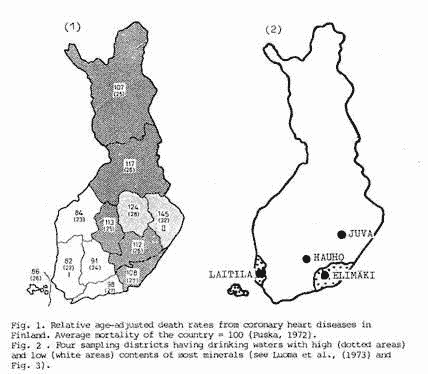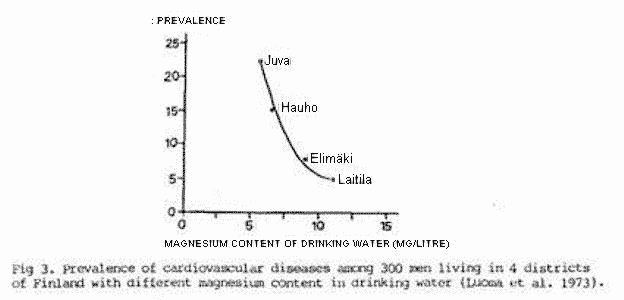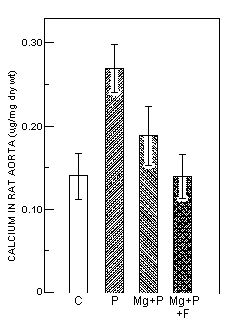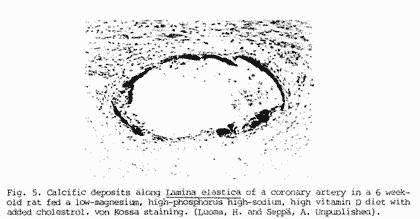Magnesium in Health and Disease: Y. Itokawa & J.
Durlach, eds. © 1989 John Libbey & Co Ltd. pp
183-190.
Risk of myocardial infarction in relation to magnesium and
calcium concentrations in drinking water, with some aspects on
the magnesium vs. fluoride interactions
Heikki Luoma
Department of Preventive Dentistry and Cariology, University
of Kuopio, Kuopio, Finland.
According to the letter of Dr. Itokawa, fall 1987, the
organizing Committee proposed me to present a paper on my own
work on the risk of myocardial infarction in relation to
magnesium and calcium concentration in drinking water. My
presentation will meet this initial proposal. However, studies of
my group on this topic were primarily initiated by need of
learning more about the safety of the increased intake of
fluoride for prevention of tooth decay. Therefore, fluoride
became an essential part of our studies from the very beginning.
For the same reason, the fluoride cannot entirely be excluded
from this presentation either.
The basic hypothesis of our work was that increased intake of
fluoride may possibly promote the prevalence of cardiovascular
diseases, including myocardial infarction, among subjects who may
otherwise be susceptible to them. If that hypothesis would be
true, fluoride intake should be reduced, or perhaps the
suitability of fluoride could be improved by other ions, such as
magnesium.
In the early 1970'ies, several excellent epidemiological
articles and reviews were available relating the prevalence of
cardiovascular diseases to the quality of drinking water or diet
(Kobayashi, 1957; Schroeder, 1960; Seelig and Heggtveit, 1974),
and especially to their magnesium content (Marier, 1968; Neri et
al., 1975 and others).
As to Finland, who in the beginning of the l970'ies was on top
regarding the prevalence of cardiovascular diseases, the
ischaemic heart disease was associated by Karppanen and Neuvonen
(1973) in part to the low soil magnesium and, further, to low Mg
in drinking water. In fact, the relative age-adjusted death rate
from coronary heart diseases in 1969 was highest in the
easternmost Finland (Puska, 1972, Fig. 1), where largest areas of
low-Mg soils exist (Kurki, 1972).
For us these data were enough to include magnesium as one of
the elements of drinking waters, that we analyzed in our first
field study (Luoma et al., 1973). In this study we compared the
prevalence of cardiovascular diseases to the magnesium and
fluoride content of drinking water among 300 men living in
different rural districts of Finland and who had drank the same
water for several years. 350 of these districts were from areas,
where the well waters had distinctly higher contents of many
elements than the wells in rural Finland in general (Fig. 2).


According to Fig. 3, the percentage prevalence of all
cardiovascular diseases was four times higher in the district of
Juva with the average Mg-concentration of 5.8 ppm in drinking
water, as compared to the CV-prevalence in the district of
Laitila where the average water Mg-content was 11.0 ppm. The
percentage prevalence of ischaemic heart disease in the
respective extreme districts were 8.6 (Juva) and 1.1 (Laitila).
The mean serum cholesterol values were 286 and 272 mg/100 ml,
serum potassium 5.43 and 4.61 mM/l, and water F-contents 0.05 and
2.57 ppm, respectively.
Ten years later we published another field study, also of a
pilot nature, on the possible association of magnesium, calcium,
and fluoride content of drinking water to the risk of myocardial
infarction among Finnish men (Lucina et al. 1983). The final
group of infarction cases contained 30 - 64 -year-old men that
had been treated in the Central Hospital of Town of Kotka (in
South-Eastern Finland) for their first myocardial infarction. The
hospital control group contained men who had been treated
surgically in the same hospital during the same year as the
cases. As the population control group we had men selected from
the population register of the same area and who were not
hospitalized. After several exclusions were made on the basis of
additional informations, we finally had 50 case-hospital control
pairs and 50 case-population control pairs. Table 1 shows that
the increasing magnesium concentration of the drinking water was
associated with decreasing relative risk of infarction in each
comparison. Fluoride exhibited a similar relationship, especially
in the case/hospital control comparison. There was a trend of
increasing risk with the increase in water calcium content.
Table 1. Decreasing relative risk (RR) of acute myocardial
infarction along with increasing magnesium (and fluoride)
level in drinking water (Luoma et al. 1983).
Element
in water |
Concentr.
cut-off
limit (ppm) |
Case/hosp.control
RR
|
Case/popul.control
RR
|
|
| Mg |
1.2 |
2.00
|
4.67
|
|
1.5 |
1.11
|
2.29
|
|
3.0 |
1.00
|
1.63
|
|
|
|
|
| F |
0.1 |
3.00
|
4.40
|
|
0.3 |
2.17
|
6.33
|
|
0.5 |
1.63
|
6.33
|
|
1.0 |
0.91
|
2.33
|
|
|
|
|
| Ca |
16 |
0.73
|
0.56
|
|
18 |
0.77
|
1.07
|
|
20 |
0.91
|
1.64
|
|
The results of these two field studies were consistent with
the widely accepted view, that low magnesium intake is associated
with increased risk of cardiovascular diseases, including
myocardial infarction. The results on fluoride support a
hypothesis on a similar association, earlier suggested by
Bernstein et al. (1966). The data on coronary heart disease and
constituents of drinking water in East- and West-Finland (Punsar
et al., 1975), were in line with the Mg- and F-data of both of
our studies.
In the early 1970'ies, some evidence had accumulated
concerning the reduction by magnesium of arteriosclerotic
calcifications or even myocardial infarctoid changes or necroses
of experimental animals, as shown by Selye (1958a), Rigo and
coworkers (1963) and Savoie (1972) and reviewed by Pyke
(1973).
We also had to perform animal experimentations on the effect
of magnesium and fluoride intake on the cardiovascular health,
partly to justify our clinical field studies, mentioned
above.
In the attempts to produce myocardial infarctions in rats we
only could confirm the previous information (Selye, 1958a;
Mishra, 1960; Seta et al. 1965) that infarctions only occur in
the inner layers of rat myocardium. We considered this model less
suitable for further experimentation. Therefore, we preferred to
quantify the possible modification of the pathologic calcium salt
accumulation in the cardiovascular system of rats by elevated
dietary Mg and F.

Fig. 4. Elevation by orthophosphate
feeding of the calcium content of aorta in rats fed a
low-Mg basic diet and the inhibition exerted by magnesium
and fluoride additions in diet (Luoma et al.,
1976). |
Figure 4 shows the results of our first rat experiment (Luoma
et al. 1976). In rats fed a low Mg diet (0.046 % 4) an
orthophosphate addition (2 %
NaH2PO4-H2O to the diet doubled
the aortic calcium. Magnesium added with phosphate (40 ppm Mg)
prevented in part the calcium accumulation in the aorta, while
magnesium plus fluoride (15 ppm F) in whole diet, added with
phosphate and magnesium, could completely prevent the effect
caused by phosphate addition alone.
Four animal studies published by our groups so far (Luoma at
al., 1976; Luoma and Nuuja, 1977; Lucas et al., 1981 and
Ericsson, Luoma and Ekberg, 1987) demonstrated the effectiveness
of increased magnesium intake in reduction of calcium
accumulation in aorta or heart muscle.
In the last animal study (Ericsson, Luoma and Ekberg, 1987) we
had seven groups of rats (Table 2). There was a basal group (B)
with normal diet. The rest of groups had an imbalanced diet (I)
with low calcium and magnesium and high phosphorus contents. In
the drinking water of the 5 imbalance groups, calcium, magnesium
or fluoride or their combinations were added.
Table 3 shows that in the imbalance group having no additions
in the drinking water, plasma calcium and magnesium were slightly
reduced, aortic calcium was reduced by one fourth and aortic
magnesium as well as heart magnesium slightly.
Table 2. Composition of the different diets and drinking
water of rats for observations on the effects of drinking
water additives on the calcium, magnesium and fluoride
content of plasma and the cardiovascular system (Ericsson,
Luoma and Ekberg, 1987).
|
| Group. designation |
Solid diet (analyzed |
|
|
Ca |
P |
Mg |
|
K |
Drinking water (calculated) |
|
|
% |
|
ppm |
|
% |
|
| B, balanced |
0.43 |
0.43 |
485 |
|
0.48 |
Distilled water |
| I, imbalanced |
0.12 |
0.82 |
98 |
|
0.19 |
Distilled water |
| I + Ca |
0.12 |
0.82 |
98 |
|
0.19 |
Distilled water with 0.2 % Ca as gluconate |
| I + Mg |
0.12 |
0.82 |
98 |
|
0.19 |
Distilled water with 200 ppm Mg as sulfate |
| I + F |
0.12 |
0.82 |
98 |
|
0.19 |
Distilled water with 30 ppm F as
Na2PO3F (MFP) |
| I + Ca + F |
0.12 |
0.82 |
98 |
|
0.19 |
Distilled water with additives as in group I + Ca +
group I + F |
| I + Mg + F |
0.12 |
0.82 |
98 |
|
0.19 |
Distilled water with additives as in group I + Mg +
group I + F |
|
Table 3. Parameters of plasma, aorta, heart and kidneys in
different dietary groups, see table 2. (From Ericsson,
Luoma, Ekberg, 1987).
|
|
Dietary group |
|
|
| Parameter |
B |
I |
I + Ca |
I + Mg |
I + F |
I + Ca + F |
I + Mg + F |
|
| Plasma Ca, ug/ml |
85.2 |
54.4 |
82.4 |
59.6 |
49.6 |
90.0 |
54.4 |
| Plasma Mg, ug/ml |
18.2 |
14.7 |
6.0 |
21.9 |
14.2 |
6.3 |
23.5 |
| Plasma F-, ug/l |
6 |
6 |
6 |
7 |
249 |
171 |
255 |
| Aorta Ca, ug/g |
371 |
297 |
452 |
430 |
352 |
452 |
343 |
| Aorta Mg, ug/g |
266 |
235 |
227 |
240 |
218 |
241 |
248 |
| Heart Ca, ug/g |
102 |
85 |
113 |
67 |
65 |
96 |
64 |
| Heart Mg, ug/g |
1059 |
1012 |
1018 |
1042 |
1017 |
1013 |
1085 |
|
| Plasma values are means of 7 - 11 rats per
group. Other values are means of 14 - 16 rats per
group. |
Calcium addition to drinking water of the imbalanced group
reduced plasma magnesium further, elevated the calcium of the
aorta and heart above the level of the basal group. Magnesium
addition to the water of the imbalanced rats surprisingly
elevated the aortic calcium also above the level of the basal
group, but reduced heart Ca further and restored the heart
magnesium to the level found in the basal group. Fluoride
addition to drinking water of these imbalanced rats elevated
noticeably only plasma fluoride and slightly the aortic calcium,
but tended to reduce the calcium content of the heart
further.
When calcium plus fluoride were added to the drinking water,
the plasma magnesium was again reduced further (see group I).
Plasma F was not increased as much as in the former group, but
calcium in the aorta was elevated more than with the calcium
addition alone. Finally, the magnesium plus fluoride additions in
drinking water elevated plasma fluoride as much as did the
fluoride addition alone. The aortic calcium was not elevated as
much as by the magnesium addition alone. The magnesium of the
aorta in this group was highest among the imbalanced groups. In
the heart, the calcium content was lowest and the magnesium
content highest of all the seven groups. Thus the heart Mg/Ca
ratio was the highest in this group.
In our four animal studies, in which attempts were made to
modify the calcium content of the arteries, we never found any
atherosclerotic plaques. The calcium changes were generally
observable only by chemical means. In some rat series, where
dietary magnesium was very low, phosphorus and sodium high and
some cholesterol added, calcifications in the coronary arteries
of some rats could be demonstrated also by histopathological
methods (Fig.5). Calcium accumulations appeared in the Lamina
elastica that seemed to be fragmentary thus resembling the
figures shown by Selye (1958b) and Hungerford and Bernick (1980).
There was no proliferation of cells of the artery wall as shown
by Bloom (1988) in hamsters and Yamori et al. (1982) in rats.
These observations, however, are still continued.

In conclusion, with some exceptions these epidemiological and
experimental data collectively support the concept of the
protective action of magnesium of drinking water or of food
against the degenerative changes of the cardiovascular system,
including the myocardial infarction. They are in a fair
accordance with the many recent review articles or books on the
cardioprotective function of magnesium written eg. by Szelenyi
(1973); Altura (1979); Marier at al. (1979); Durlach et al.
(1980); Seelig (1980); Karppanen (1981) and by many speakers in
this symposium.
In view of the well known high consumption of animal fats and
sodium by the Finnish people, the marginally safe daily intake of
magnesium from food by the Finns (Varo and Koivistoinen, 1980)
and the probably indirect reduction of its utilization by dietary
calcium and phosphorus (Seelig, 1980), which are high in the
average Finnish food (1.5 and 2.0 g/day, respectively) (Varo and
Koivistoinen, 1980), the magnesium in most of our drinking waters
seems insufficient essentially to contribute to the safe total
Mg-intake in all population subgroups. Thus the need of further
research and the present endeavours to increase the magnesium
intake by our people, as proposed by Karppanen (1981), seem
justified.
The findings that small elevations of fluoride alone or
especially with magnesium in food or drinking water were also
protective, were in agreement with the review and conclusions by
Hegsted (1967), Pyke (1973) and Marier (1980) on the interaction
of these ions in modifying different calcium salt imbalances.
Our results were thus not in agreement with our starting
hypothesis, that fluoride ingested in amounts, sufficient for
prevention of tooth decay, would be harmful to the cardiovascular
system. In fact, the reverse seemed to be true.
Since, however, time and space are limited, this most
interesting interaction remains to be dealt with more extensively
in other contexts.
REFERENCES
Altura, B.M. (1979): Sudden-death ischemic heart disease and
dietary magnesium intake -- is the target-site coronary vascular
smooth muscle? Med. Hypoth. 5, 843-8
Altura, B.M. (1988): Ischemic heart disease and magnesium.
Magnesium 7, 57-67
Bernstein, D.D.; Sadowsky, N.; Hegsted, D.M.; Guri, C.D.;
Stare, F.J. (1966): Prevalence of osteoporosis in high-and
low-fluoride areas in North-Dakota. J. Amer. Med. Assoc.
198, 499-504
Bloom, S. (1985): Coronary arterial lesions in Mg-deficient
hamsters. Magnesium 4, 82-95
Durlach, J.; Rayssiguier, Y.; Laguitton, A. (1980): La besoin
en magnesium et son apport dans la ration. Med. Nutr.
16, 15-21
Ericsson, Y.; Luoma, H.; Ekberg, O. (1987): Effects of
calcium, fluoride and magnesium supplementations on tissue
mineralization in calcium- and magnesium-deficient rats. J.
Nutr. 116, 1018-1027
Hegsted, D.M. (1967): Mineral intake and bone loss. Feder.
Proc. 26, 1747-1754
Hungerford, G.F.; Bernick, S. (1980); Response of rat coronary
arteries to dietary magnesium deficiency with and without
cholesterolemia. In Magnesium in Health and Disease ed.
M. Cantin, M.S. Seelig, pp. 659-670 Jamaica, N.Y.: Spectrum
Publications, Inc.
Karppanen, H.; Neuvonen, P.J. (1973): Ischaemic heart disease
and soil magnesium in Finland. Lancet Dec. 15, 1390
Karppanen, H. (1981): Epidemiological studies on the
relationship between magnesium intake and cardiovascular
diseases. Artery 9, 190-199
Kobayashi, J. (1957): Geographical relation between the
chemical nature of river water and death-rate from apoplexy.
Ber. Ohara Inst. landwirtsch. Biol. 11, 12-21
Kurki, M. (1972): Suomen peltojen viljavuudesta II
(On the fertility of the cultivated soils in Finland) pp. 1-182,
Helsinki: Yhteiskirjapaino Oy
Luoma, H.; Helminen, S.K.J.; Santa, H.; Rytömaa, I.;
Meurman, J.H.(1973): Relationships between the fluoride and
magnesium concentrations in drinking water and some components in
serum related to cardiovascular diseases in men from four rural
districts in Finland. Scand. J. Clin. Lao. Invest 32,
217-224
Luoma, H.; Nuuja, T.; Collan, Y.; Nummikoski, P. (1976): The
effect of magnesium and fluoride on nephrocalcinosis and aortic
calcification in rats given high sucrose diets with added
phosphates. Calcif. Tissue Res. 20, 291-302
Luoma, H.; Nuuja, T. (1977): Caries reduction in rats by
phosphate, magnesium and fluoride additions to diet with
modifications of dental calculus and calcium of the kidneys and
aorta. Caries Res. 11, 100-108
Luoma, H.; Seppä, L.; Laurell, P.; Hurskainen, R.;
Koskinen, M.; Karppanen, H. (1981): Fluoride and magnesium intake
in relation to atherosclerosis, dental caries and renal calculus
in rats. In Fluoride metabolism eds Binder, K.,
Hohenegger, M., pp. 91-117 Mien: Werlag Wilhelm Maudrich
Luoma, H.; Aromaa, A.; Helminen, S.; Murtomaa, H.; Kiviluoto,
L.; Punsar, S.; Knekt, P. (1983): Risk of myocardial infarction
in Finnish men in relation to fluoride, magnesium and calcium
concentration in drinking water. Acts Med. Scand. 213,
171-176
Marier, J.R. (1968): The importance of dietary magnesium with
particular reference to humans. Z. Vitalstoffe
Zivilizationskranktheiten 13 144-149
Marier, J.R.; Neri, L.C.; Anderson, T.W. (1979): Water
hardness, human health and the importance of magnesium pp.
1-119 Ottawa: National Research Council Canada
Marier, J.R. (1980): Observations and implications of the
Mg-vs-F in interrelations in biosystems. A review. Proc.
Finn. Dent. Soc. 76, 93-102
Mishra, R.K. (1960): Studies on the experimental magnesium
deficiency in the albino rat. 1. Functional and morphologic
changes associated with low intake of magnesium. Rev. Can.
Biol. 19, 122-135
Neri, L.C.; Hewitt, D.; Schreiber, G.B.; Anderson, T.W.;
Mandel, J.S; Zdrojewsky, A. (1975): Health aspects of hard and
soft waters. J. Amer. Water Works Assoc. 67, 403-409
Punsar, S.; Erämetsä, O.; Karvonen, M.;
Ryhänen, A.; Hilska, P.; Vornamo, H. (1975): Coronary heart
disease and drinking water. A search in two Finnish male cohorts
for epidemiologic evidence of a water factor. J. Chron.
Dis. 28, 259-287
Puska, P. (1972): Sydän- ja verisuonisairauksien
aiheuttaman kuolleisuuden alueelliset erot. Tilanne vuoden 1969
tietojen valossa (Regional differences in the mortality from
cardiovascular diseases. The situation in the light of 1969 data)
Suom. Lääk. l. 27, 3071-3075
Pyke, R.E. (1973): Relationships of calcium, phosphorus,
magnesium and fluoride in hard- and soft- tissue calcification.
In Biological mineralization ed Zipkin, I. pp. 463-485,
New York, John Wiley & Sons
Rigo, J.; Simon, G. Hegyvari, C.; Sos, J. (1963): Effect of
magnesium on dietary infarctoid changes in the heart. Acta
Med. Acad. Sci. Hung. 19, 231-236
Savoie, L.L. (1972): Role du magnésium, du potassium,
d'antikaliurétiques, et d'hypo-cholesterolémiants
dans le dévelopement de lésions cardiaques chez le
rat nourri avec un régime thrombogéne et le
Na2HPO4. Pathol. Biol. 20,
751-756
Schroeder, H.A. (1960): Relations between mortality from
cardiovascular disease and treated water supplies. J. Amer.
Med. Assoc. 172, 1902-1908
Selye, H. (1958a): On the site of interaction between
NaH2PO4 and MgCl2 or KCl in the
prevention of phosphate-steroid cardiopathy. Acta
Endocrinol. 28, 273-278
Selye, H. (1958b): Prophylactic treatment of experimental
arteriosclerosis with magnesium and potassium salts. Amer.
Heart J. 55, 805-809
Seta, K.; Hellerstein, E.; Vitale, J.J. (1965): Myocardium and
plasma electrolytes in dietary magnesium and potassium deficiency
in the rat. J. Nutr. 87, 179-188
Seelig, M.S. (1980) Magnesium deficiency in the
pathogenesis of disease pp. 141- 264. New York, Plenum
Medical Book Co
Seelig, M.S.; Heggtveit, H.A. (1974): Magnesium
interrelationships in ischemic heart disease: A review. Am.
J. Clin. Nutr. 24, 59-79
Szelenyi, I. (1973): Magnesium and its significance in
cardiovascular and gastrointestinal disorders. World Rev.
Nutr. Dietet. 17, 189-221
Varo, P.; Koivistoinen, P. (1980): Mineral element composition
of Finnish Foods. XII General discussion and nutritional
evaluation, in Mineral element composition of Finnish Foods:
N, K, Ca, Mg, P, S, Fe, Cu, Mn, Zn, Mo, Co. Ni, Cr, F, Se, Si,
Rb, Al, B, Br, Hg, As, Cd, P and ash. ed P. Koivistoinen pp
165-171 Acta Agricult. Scand. Stockholm, Suppl. 22
Yamori, Y. Kihara, M.; Nara, Y.; Horie, R. (1982): Myocardial
ischemic rats (MIR). Coronary vascular alteration induced by a
lipid-rich diet. Atherosclerosis 42, 15-20
This page was first uploaded to The Magnesium Web Site on
August 13, 2002
http://www.mgwater.com/




